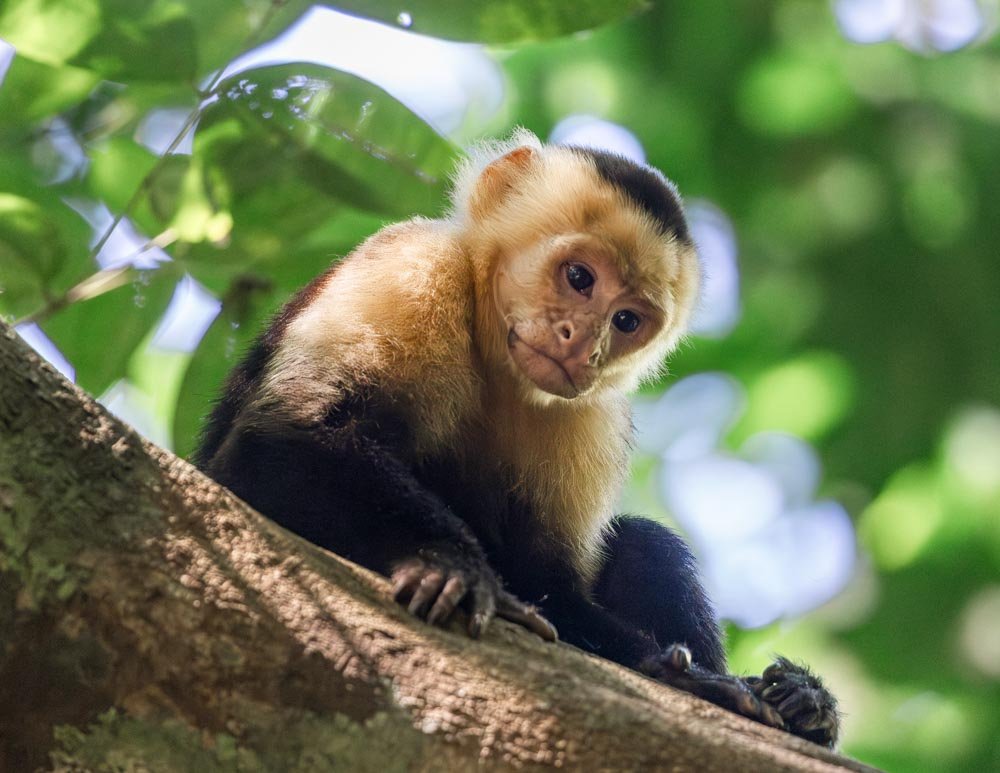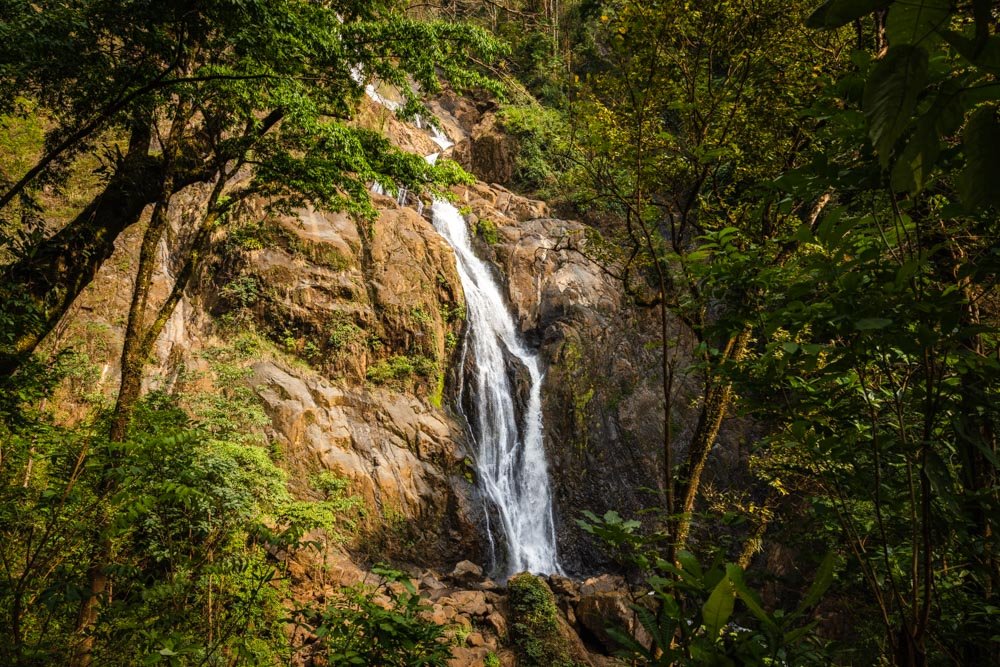Scarlet macaws have to be some of the most beautiful birds in the entire world. There is nothing like seeing one glide overhead in the wild and the sense of awe was as great for our 12th sightings as our first. They have a prehistoric sounding call and hearing it as we hiked through the jungle was one of my most memorable moments in Costa Rica.
I’d been lucky enough to see Scarlet macaws on a previous trip to Central America, but Joe hadn’t, so finding one was one of our many wildlife spotting missions in Costa Rica. We would have been happy to see just one, but ended up seeing dozens in many locations, the best of which we’ll share the details of below.
This isn’t going to be a guide with lots of facts about Scarlet macaws (known as Lapas in Costa Rica), because we’re no experts, but if you’re looking for the best spots to find them, we have you covered.
Where to find Scarlet macaws in Costa Rica
Although there are many places to see Scarlet macaws in Costa Rica, the first two on our list are where we saw the most. We saw over 20 in spot one and 12 in spot two alone.
There are several other great places to see them, which we didn’t personally visit, so if you’re headed to either Puerto Jimenez or Corcovado National Park, then it’s pretty much guaranteed you’ll see them there too.
If you aren’t planning to head to Drake Bay (our top spot), I’d say the easiest place to see them and the one you are most likely to visit as it’s so close to Manuel Antonio, is Jaco.
1. Drake Bay
We knew we’d likely find a Scarlet macaw in Drake Bay; what we didn’t realise is just how many we would see. It was a truly wonderful experience.
We saw a number fly over the town centre and past our accommodation (two had made a nest in the tree by Drake Divers and were easy to spot daily), but it was on the Drake Trail that we saw countless numbers.
Scarlet macaws love to snack on almonds and there are plenty of almond trees lining the beaches of the Drake Trail.
There were a large number of them on the Playa Iris part way along the trail, in the almond trees on the path between San Josecito Beach and Sunset Restaurant at Playa Rincon, and at the abandoned hotel less than 2km from Playa Rincon (full details of which are in this guide).
It’s more than likely you will see many without needing these specific spots, but just in case we wanted to give some indication of where we saw many in one place. The Drake Trail is quite a long walk, but you can opt to walk a section of it and still find incredible beaches and of course Scarlet macaws.
Boats and taxis run to certain beaches along the way (Playa San Josecito and Playa Rincon) which are both very much worth visiting when in Drake Bay and offer shorter walks to other spots along the Drake Trail.
2. Bijagual Falls - Jaco
We saw more macaws (8) than humans (2) on the Bijagual Falls trail, just outside of Jaco. The walk itself is along one of the more rustic trails in Costa Rica and takes you to the bottom of the tallest waterfall in the country.
The steep and sometimes slippery path will not be for everyone, but it felt incredibly wild, especially with the calls of the Scarlet macaws continuously overhead. The scenery and sounds were Jurassic Park-esque.
For those that don’t like the sound of the trail, it might be worth driving up to the trailhead (details in the post linked above) and having a look from the viewpoint next to the entry point where you buy your trail tickets. We saw three from here!
We also saw four Scarlet macaws flying over Jaco town centre with no effort whatsoever. We also saw two fly over the Crocodile Bridge, which is on route to Jaco and very much worth a stop to see the crocs lurking in the river below the bridge.
3. Carara National Park, near Jaco
We’d heard that Carara National Park was one of the best places in the country to see Scarlet macaws. However, we made the mistake of heading along the loop that leads directly from the ranger station, which takes you into dense forest.
A better move would have been the Laguna Meándrica Trail, which begins down the road from the ranger station and is out in the open. By the time we realised our mistake, it was so scorching hot that we decided not to tackle the lake trail.
However, we got chatting to the ranger and he told us about a nest just a few kilometres away from the national park where we got lucky spotting two Scarlet macaws. The pair kept popping in and out of the nest and seemed very relaxed, so we could observe them for as long as we liked, which was very special.
If you head into the national park and don’t spot one, then definitely ask the rangers because they know all the best spots and were happy to help - this was after buying our national park ticket, I don’t think we’d have had the same response if we just rocked up and asked : )
Possible sightings
Manuel Antonio/Quepos
Some people do spot Scarlet macaws in Manuel Antonio National Park, but it’s less common.
A pair were nesting in a broken palm tree on route 235 on the road between Quepos and Las Palmas, but I don’t know if it’s a place for regular sightings, or we just got lucky (we saw them several times here).
We forgot to pin the exact location, but the rough area can be found on Google Maps here and you could always check with a local to see if they’re still around.
Where to see Great green macaws in Costa Rica
The Great green macaws are just as majestic as their scarlet counterparts, albeit slightly less colourful. Although they can be found in several places on the Caribbean side of Costa Rica, we personally saw many in Tortuguero.
In fact, just five minutes after getting off the boat from the mainland we found them snacking in the trees along the back streets of the village. We saw and heard them daily at our accommodation and saw them fly overhead many times when out kayaking on the river.
There were also four snacking on almonds on the The Jaguar Trail (El Jaguar terrestrial trail) in the national park, which is right by the village.
We saw two different pairs in the trees between the beach and the coastal forest (ie not the dense jungle at the start of the walk). You will no doubt hear them before you see them!
Keep them wild
I know that 99.9% of people would never dream of feeding or trying to pet the macaws, but please remember to keep them wild. No human food will be good for them and sadly we did see tourists feeding animals like Coatis in Costa Rica and it makes them really sick. It’s unlikely any bird would ever let anyone close enough to pet it, but just incase : )
This post may contain affiliate links, meaning at no additional cost to you, we will earn a small commission if you click through and decide to make a purchase. This helps towards the costs of running our website. Thanks for your support.












































